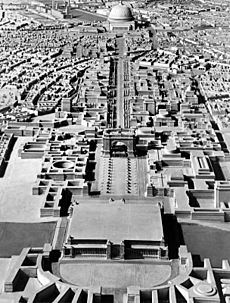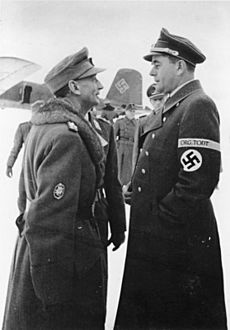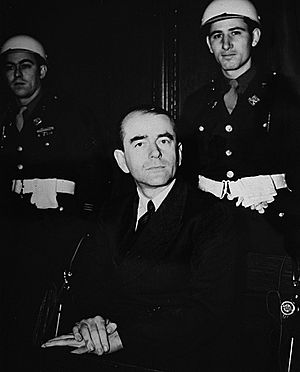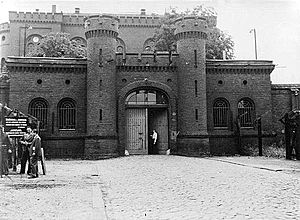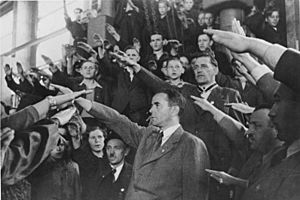Albert Speer facts for kids
Quick facts for kids
Albert Speer
|
|
|---|---|
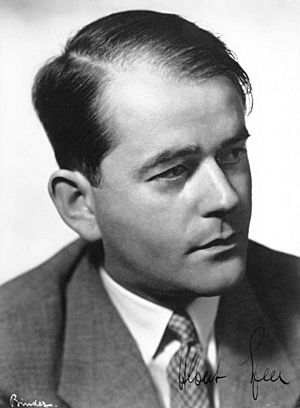
Speer in 1933
|
|
| Reich Minister of Armaments and War Production | |
| In office 8 February 1942 – 30 April 1945 |
|
| Führer | Adolf Hitler |
| Preceded by | Fritz Todt (as Minister of Armaments and Munitions) |
| Succeeded by | Karl Saur (as Minister of Munitions) |
| Reich Minister of Industry and Production | |
| In office 3 May 1945 – 23 May 1945 |
|
| Head of state | Karl Dönitz |
| Head of government | Lutz Graf Schwerin von Krosigk |
| Preceded by | Position established |
| Succeeded by | Position abolished |
| Inspector General of German Roadways | |
| In office 8 February 1942 – May 1945 |
|
| Preceded by | Fritz Todt |
| Succeeded by | Position abolished |
| Inspector General for Water and Energy | |
| In office 8 February 1942 – May 1945 |
|
| Preceded by | Fritz Todt |
| Succeeded by | Position abolished |
| Head of Organization Todt | |
| In office 8 February 1942 – 14 April 1944 |
|
| Preceded by | Fritz Todt |
| Succeeded by | Franz Xaver Dorsch |
| General Building Inspector for the Reich Capital |
|
| In office 30 January 1937 – May 1945 |
|
| Preceded by | Position created |
| Succeeded by | Position abolished |
| Personal details | |
| Born |
Berthold Konrad Hermann Albert Speer
19 March 1905 Mannheim, Grand Duchy of Baden, German Empire |
| Died | 1 September 1981 (aged 76) London, England |
| Political party | Nazi Party (1931–1945) |
| Spouse |
Margarete Weber
(m. 1928) |
| Children | 6, including Albert, Hilde, Margarete |
| Parents |
|
| Alma mater |
|
| Profession | Architect, government official, author |
| Cabinet | Hitler cabinet Schwerin von Krosigk cabinet |
| Signature |  |
| Criminal conviction | |
| Criminal status | Released (1966) Deceased (1981) |
| Conviction(s) | War crimes Crimes against humanity |
| Trial | Nuremberg trials |
| Criminal penalty | 20 years imprisonment |
| Details | |
| Victims | Millions |
| Target(s) | Slave laborers; Soviet prisoners of war and others |
| Imprisoned at | Spandau Prison |
Berthold Konrad Hermann Albert Speer (19 March 1905 – 1 September 1981) was a German architect who became a powerful government official in Nazi Germany during World War II. He was a close friend and advisor to Adolf Hitler. Speer was later found guilty of serious crimes at the Nuremberg trials and spent 20 years in prison.
Speer trained as an architect and joined the Nazi Party in 1931. His skills in design quickly made him important within the party. He became part of Hitler's inner circle. Hitler asked him to design and build major structures, including the Reich Chancellery and the Nazi party rally grounds in Nuremberg. In 1937, Speer became the General Building Inspector for Berlin. In this role, he was involved in forcing Jewish families out of their homes in Berlin. In February 1942, Speer was made the Minister of Armaments and War Production. He claimed to have greatly increased Germany's weapons production, which was believed to have helped Germany continue the war. In 1944, Speer created a special group to make more fighter aircraft. This group played a key role in using forced labor for the German war effort.
After the war, Speer was one of 24 important Nazi leaders arrested and charged with crimes. He was found guilty of using forced labor and other serious crimes against humanity. He avoided a death sentence and was released from prison in 1966. Speer wrote two books about his time in the Third Reich and prison: Inside the Third Reich and Spandau: The Secret Diaries. These books were very popular because they offered an inside look at Nazi Germany. Speer died in 1981. Not much of his architectural work still exists today.
Through his books and interviews, Speer tried to present himself as someone who deeply regretted not knowing about the terrible crimes of the Nazi regime. He continued to say he didn't know about the the Holocaust. This idea of him as an "apolitical technocrat" (someone who only cared about technology and not politics) was widely believed for many years. However, historians later showed that much of the increase in Germany's arms production was due to earlier systems and that Speer was very much involved in the persecution of Jewish people.
Early Life and Family
Albert Speer was born in Mannheim, Germany, into a wealthy family. He was the second of three sons. In 1918, his family moved to Heidelberg. Speer enjoyed sports like skiing and mountaineering. He decided to study architecture, following in his father's and grandfather's footsteps.
Speer began his architecture studies at the University of Karlsruhe in 1923. In 1924, he moved to the Technical University of Munich. In 1925, he transferred again to the Technical University of Berlin. There, he studied under Heinrich Tessenow, whom he greatly admired. After passing his exams in 1927, Speer became Tessenow's assistant. This was a great honor for a 22-year-old.
In 1922, Speer started dating Margarete Weber. They married in Berlin on 28 August 1928. They had six children together. However, Speer became less close to his family after 1933. This distance continued even after he was released from prison in 1966.
Becoming a Nazi Architect
Joining the Nazi Party (1931–1934)
In January 1931, Speer joined the Nazi Party. He became member number 474,481. During the Great Depression, Speer lost his job as Tessenow's assistant. He moved to Mannheim, hoping to work as an architect. When that didn't work out, his father gave him a part-time job managing his properties. In July 1932, Speer visited Berlin to help the Nazi Party before an election. A friend suggested Speer to Joseph Goebbels to help renovate the Party's Berlin headquarters. After this job, Speer returned to Mannheim.
The organizers of the 1933 Nuremberg Rally asked Speer to design parts of the event. This was his first meeting with Hitler. Hitler was impressed with Speer's work. This led to Speer's first national job as the Nazi Party's "Commissioner for the Artistic and Technical Presentation of Party Rallies and Demonstrations."
Hitler wanted to rebuild the Chancellery building. In late 1933, he hired Paul Troost to renovate it. Hitler appointed Speer to manage the construction site for Troost. Hitler visited the site daily and often invited Speer to lunch. Speer quickly became part of Hitler's close circle. He was expected to meet Hitler often to discuss architecture and other ideas.
Speer later claimed he had little interest in politics and joined the party almost by chance. However, historians note that his actions showed he was deeply involved in the Nazi regime's policies, including those against Jewish people. Speer's main goals were to gain power, control, and wealth.
Nazi Architect (1934–1937)
When Paul Troost died in January 1934, Speer became the Party's main architect. Hitler made Speer head of the Chief Office for Construction.
One of Speer's first big projects was the Zeppelinfeld stadium in Nuremberg. This stadium was used for large Nazi propaganda rallies. It could hold 340,000 people. Speer designed the lighting effects to make the rallies look more impressive, especially at night. Many Nazi buildings were planned for Nuremberg. Speer also modified the design for the Olympic Stadium in Berlin for the 1936 Summer Olympics. He added a stone exterior that Hitler liked. Speer also designed the German Pavilion for the 1937 international exhibition in Paris.
Berlin's General Building Inspector (1937–1942)
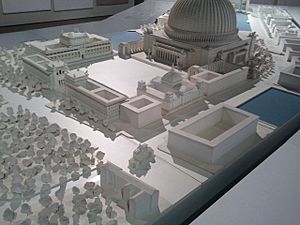
On 30 January 1937, Hitler appointed Speer as the General Building Inspector for Berlin. This gave him great power over the city government. He reported directly to Hitler. Hitler ordered Speer to create plans to rebuild Berlin into a grand capital. These plans included a three-mile-long boulevard called the Prachtstrasse, or Street of Magnificence. At one end, Speer planned the Volkshalle, a huge domed hall over 700 feet (210 m) high for 180,000 people. At the other end, a massive triumphal arch, almost 400 feet (120 m) high, was planned. World War II starting in 1939 stopped these plans.
Speer was also involved in building a new Reich Chancellery. Construction began in 1936. Speer was given special powers to finish the Chancellery by January 1939. To speed up work, construction workers had to work long shifts. The Schutzstaffel (SS) built two forced labor camps in 1938. They used prisoners from these camps to quarry stone for the Chancellery. A brick factory was also built near a camp at Speer's request. The Chancellery was finished in early 1939.

During the Chancellery project, a violent attack against Jewish people and their property, known as Kristallnacht, took place. Speer later added a mention of seeing the ruins of a synagogue in Berlin. From 1939, Speer's department used Nazi laws to force Jewish tenants out of their homes in Berlin. These homes were then given to non-Jewish people who had been displaced by building projects or bombing. About 75,000 Jewish people were forced from their homes. Speer later claimed he did not know they were being sent away on trains. However, historians have shown that Speer was deeply involved in the persecution of Jewish people.
When Germany started World War II, Speer created teams to build roads and clear debris. These teams later cleared bomb sites. Speer used forced Jewish labor for these projects, alongside German workers. Building plans for Berlin and Nuremberg stopped as more resources were needed for the war. Speer's offices also built structures for the military and the SS, often using forced labor. Speer became one of the wealthiest Nazi leaders because of his building work.
Minister of Armaments
Taking Control and Gaining Power
On 8 February 1942, the Minister of Armaments, Fritz Todt, died in a plane crash. Hitler appointed Speer to take his place. Speer also took over Todt's other important roles, including Inspector General of German Roadways and Head of the Organisation Todt, a large government construction company. Hitler did not give Speer clear instructions, so Speer had to fight other leaders for power. Speer wanted control over all armaments production. He gained Hitler's support. By March 1942, Speer was named "General Plenipotentiary for Armament Tasks." Speer was ambitious and determined. He worked to control not just army weapons but all military production. By April 1942, Speer had gained supreme authority over raw materials and production schedules.
Speer was praised for an "armaments miracle" because German war production seemed to increase greatly under his leadership. This increase slowed down in mid-1943 due to Allied bombing. However, historians now say that other factors contributed more to the increase than Speer himself. Production had already started to rise under Todt. Also, naval and air force armaments were not under Speer's control until much later, but they also showed similar increases. Another reason for the increase was more coal being sent to the steel industry. Weapons production peaked in mid-1944, but by then, there was a severe fuel shortage. Without fuel, offensive actions became impossible, and weapons sat unused.
As Minister of Armaments, Speer was in charge of supplying weapons to the army. He decided to focus on tank production. Hitler was very involved in tank design, but his constant changes delayed the program. This meant that despite tanks being a top priority, little money was spent on them. This contributed to a German Army failure at the Battle of Prokhorovka on the Eastern Front.
As head of Organisation Todt, Speer was directly involved in building and changing forced labor camps. He approved expanding Auschwitz and other camps, allocating money for new huts, gas chambers, crematoria, and morgues. The SS called this "Professor Speer's Special Programme."
Speer realized that with millions of workers in the armed forces, there was a shortage of labor for his factories. Hitler appointed Fritz Sauckel to find new workers. Speer and Sauckel worked closely. Hitler gave Sauckel freedom to get workers, which Speer liked. Sauckel forced people from villages in France, Holland, and Belgium to work in Speer's factories. He used brutal methods. By April 1943, Sauckel had supplied over 1.5 million forced laborers, prisoners of war, and concentration camp prisoners to Speer's factories. Speer was later convicted for the mistreatment of these people.
Bringing Arms Production Together

After becoming Minister of Armaments, Speer only controlled army weapons. He wanted to control weapons production for the air force (Luftwaffe) and navy (Kriegsmarine) too. He worked hard to increase his power. His close relationship with Hitler protected him, allowing him to outsmart his rivals. By July 1943, he controlled armaments production for the Luftwaffe and Kriegsmarine. In August 1943, he took control of most of the Ministry of Economics. His title changed to "Reich Minister for Armaments and War Production." He became one of the most powerful people in Nazi Germany.
Speer and his team tried to improve shipbuilding by using new methods. They tried to build new submarines, the Type XXI and Type XXIII, in prefabricated sections at different places. This idea did not work well. The designs were rushed, and the finished submarines had many flaws. Few of them ever entered service.
In December 1943, Speer injured his knee and was unable to work for several months. In January 1944, he became seriously ill. Concerned about keeping his power, he continued to direct the Armaments Ministry from his bed. During his illness, the Allies bombed German aircraft factories, causing great damage. Speer's rivals used this chance to weaken his authority. He began to lose Hitler's full support and some of his power.
To respond to the Allied bombing, Hitler created a special committee called the Fighter Staff. Its goal was to increase fighter aircraft production. This committee was set up by March 1944. German fighter aircraft production more than doubled between 1943 and 1944. However, many of these planes were older models that were easily defeated by Allied aircraft. In August 1944, Speer combined the Fighter Staff into a new committee.
The Fighter Staff committee played a key role in increasing the use of forced labor in the war economy. The SS provided 64,000 prisoners from various forced labor camps for 20 projects. Prisoners worked for major companies like Junkers, Messerschmitt, Henschel, and BMW. To increase production, Speer introduced harsh punishments for workers. Those who pretended to be sick, were lazy, or tried to escape were denied food or sent to forced labor camps. By 1944, this was very common. Over half a million workers were arrested. Many people worked in Speer's underground factories, which were very dangerous places with brutal discipline and regular executions.
The biggest technological advance under Speer was the rocket program. Speer strongly supported this program. In March 1942, he ordered the production of A4 rockets, which became the V-2 rocket, the world's first ballistic missile. These rockets were built at an underground factory using forced labor from the Mittelbau-Dora camp. Of the 60,000 people at this camp, 20,000 died due to the terrible conditions. The rocket program was very expensive and did not significantly help the war effort.
On 14 April 1944, Speer lost control of Organisation Todt. He was not involved in the attempt to assassinate Hitler in July 1944. After the plot, Speer's rivals attacked his allies, and he lost more authority.
The End of Nazi Germany
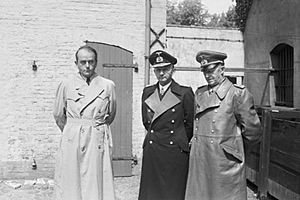
By late 1944, Germany's economy was collapsing due to territory losses and Allied bombing. Air attacks on the transport system were especially effective, cutting off coal supplies to factories. In January 1945, Speer told Goebbels that weapons production could last for about a year. However, he concluded the war was lost after Soviet forces captured the important Silesian industrial region that month. Still, Speer believed Germany should continue fighting to get better surrender terms from the Allies. In January and February, Speer claimed his ministry would deliver "decisive weapons" and greatly increase production. Speer gained control over the railways in February and asked Heinrich Himmler for forced laborers to repair them.
By mid-March, Speer accepted that Germany's economy would collapse within eight weeks. He tried to prevent the destruction of industrial facilities so they could be used after the war. However, he still supported continuing the war. On 15 March, Speer gave Hitler a report detailing Germany's terrible economic situation. He asked for approval to stop destroying infrastructure. Three days later, he suggested concentrating Germany's remaining military resources along the Rhine and Vistula rivers to prolong the fighting. Hitler rejected Speer's idea to stop demolitions. Instead, on 19 March, he issued the "Nero Decree", ordering the destruction of all infrastructure as the army retreated. Speer was horrified by this order and convinced several military and political leaders to ignore it. During a meeting with Speer, Hitler canceled the decree and gave Speer authority over demolitions. Speer stopped them, though the army continued to blow up bridges.
By April 1945, little was left of the armaments industry, and Speer had few official duties. Speer visited the Führerbunker for the last time on 22 April. He met Hitler before leaving Berlin for Hamburg. On 29 April, the day before his death, Hitler wrote his final political testament. In it, he removed Speer from the new government, replacing him with Karl-Otto Saur. Speer was disappointed. After Hitler's death, Speer offered his services to the new government led by Karl Dönitz. He became Minister of Industry and Production in this short-lived government. Speer provided information to the Allies about the effects of the air war and other topics. On 23 May, British troops arrested the members of the government, formally ending Nazi Germany.
After the War
Nuremberg Trial
Speer was taken to several detention centers and questioned. In September 1945, he was told he would be tried for serious crimes. He was moved to Nuremberg. Speer was charged with four main crimes: being part of a plan to commit crimes against peace; planning and waging aggressive wars; war crimes; and crimes against humanity.
The chief United States prosecutor, Robert H. Jackson, stated that Speer helped plan and carry out the program to force prisoners of war and foreign workers into German war industries. Speer's lawyer argued that Speer was an artist who was forced into political life and was not an ideologue.
Speer was found guilty of war crimes and crimes against humanity, mainly for using forced labor. He was found not guilty of the other two charges. He claimed he did not know about the Nazi plans to exterminate Jewish people, and the Allies had no proof he did. However, a private letter written in 1971 and made public in 2007 showed this claim was false. On 1 October 1946, he was sentenced to 20 years in prison. Three of the eight judges wanted the death penalty for Speer, but the others did not, and they agreed on a 20-year sentence after two days of discussions.
Imprisonment
On 18 July 1947, Speer was sent to Spandau Prison in Berlin to serve his sentence. He was known as Prisoner Number Five. Speer's parents died while he was in prison. His father, who died in 1947, disliked the Nazis. His mother died in 1952. Speer's friends helped his family and carried out his requests sent in letters to his wife. Speer was able to secretly send out his writings through a sympathetic orderly.
In 1949, a friend opened a bank account for Speer and raised money from architects and industrialists who had benefited from Speer's wartime activities. The money was used to support Speer's family and for bribes to try and get him released. Speer sent detailed instructions on how to use the money.
Prisoners were not allowed to write memoirs. However, Speer managed to send his writings to his friend, which eventually totaled 20,000 pages. He finished his memoirs by November 1953, which became the basis for Inside the Third Reich. In his writings, Speer tried to present himself as a tragic hero.
Speer spent much of his time in prison keeping fit, both physically and mentally. Spandau Prison had a large yard where prisoners could garden. Speer created an elaborate garden. To make his daily walks interesting, Speer imagined he was walking around the world. He carefully measured his daily distance and mapped it to real-world geography. He walked over 30,000 kilometers (18,600 miles) during his sentence. Speer also read, studied architectural journals, and learned English and French. He claimed to have read five thousand books in prison.
Speer's supporters called for his release. Among those who supported him were Charles de Gaulle and US diplomat George Wildman Ball. Willy Brandt also advocated for his release. However, the Soviet Union, which had wanted a death sentence at his trial, did not agree to a reduced sentence. Speer served his full 20-year term and was released on 1 October 1966.
Release and Later Life
Speer's release from prison was a major media event worldwide. Reporters and photographers gathered outside Spandau Prison. He gave a major interview to Der Spiegel in November 1966. Although he hoped to return to architecture, his only project was unsuccessful. Instead, he revised his prison writings into two autobiographical books: Inside the Third Reich and Spandau: The Secret Diaries. He later published a book about Himmler and the SS. Speer was helped by Joachim Fest and Wolf Jobst Siedler from the Ullstein publishing house. He found it difficult to rebuild relationships with his children. According to his daughter Hilde Schramm, "One by one my sister and brothers gave up. There was no communication."
After his release, Speer donated his personal diary, the Chronicle, to the German Federal Archives. This diary had been edited and did not mention Jewish people. A historian later found differences between the edited Chronicle and original documents. Speer asked his friend to destroy the omitted material, but his friend refused. This friend later gave access to the unedited Chronicle to a historian, who wrote the first critical book about Speer.
Speer's memoirs were very successful. People were fascinated by an inside view of the Third Reich. He provided an excuse for older Germans who had been Nazis. If Speer, who was so close to Hitler, did not know the full extent of the Nazi crimes, then they could claim the same. This idea, known as the "Speer Myth," was very strong for decades, even as historical evidence showed it was false.
Death
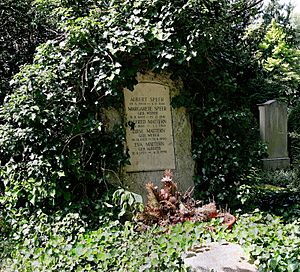
Speer made himself available to historians and researchers. In October 1973, he visited Britain for the first time for a BBC interview. He also appeared on the television program The World at War. Speer returned to London in 1981 for another BBC program. He suffered a stroke and died in London on 1 September.
His daughter, Margret Nissen, wrote in her 2005 memoirs that after his release from Spandau, he spent all his time building the "Speer Myth."
The Speer Myth
The "Good Nazi" Idea
After his release, Speer tried to present himself as the "good Nazi." He was well-educated and middle-class, which allowed him to seem different from other Nazi leaders. In his books and interviews, he changed the truth and left out important details, creating what became known as his "myths." Speer even invented details about his own birth. His "clever apologies" were often repeated in post-war Germany. Historians say that his publishers helped him create these myths. This image of the "good Nazi" lasted for decades, even though historical evidence showed it was false.
Speer carefully built an image of himself as an apolitical technocrat. He claimed he deeply regretted not knowing about the terrible crimes of the Third Reich. This idea was accepted by many historians at first. They saw him as someone who only cared about his building projects or his ministerial duties, and who thought politics was unimportant.
After Speer's death, a book showed that Speer had ordered Jewish people to be evicted from their Berlin homes. By 1999, historians had clearly shown that Speer had lied a lot. Even so, public opinion about Speer did not change much until a TV film aired in 2004. This film began to challenge the myth. Historians now say that Speer skillfully and ruthlessly moved up the ranks of the regime. He was not an apolitical technocrat but one of the most powerful and ruthless leaders in the Nazi regime. If his extensive involvement in the Holocaust had been known at his trial, he would have been sentenced to death.
The idea of the "good Nazi" was supported by many of Speer's myths. Besides claiming he was an apolitical technocrat, he also said he did not fully know about the Holocaust or the persecution of Jewish people. Another myth was that Speer revolutionized the German war machine after becoming Minister of Armaments. He was credited with a huge increase in weapons shipments, which was widely reported as keeping Germany in the war. Speer also tried to present himself as an opponent of Hitler. He falsely claimed in his memoirs that he was sympathetic to the plot to assassinate Hitler. He also falsely claimed that he realized the war was lost early on and then worked to save resources for civilians. In reality, he tried to prolong the war until further resistance was impossible, which led to many deaths and destruction in Germany's final months.
Denying Responsibility
Speer always claimed at the Nuremberg trials and in his books that he had no direct knowledge of the Holocaust. In his final statement at Nuremberg, Speer seemed to apologize, but he did not directly admit any personal guilt. Historians now state that Speer was "fully aware of what had happened to the Jews" and was "intimately involved" in their persecution. Speer was photographed with forced laborers at a camp in March 1943. Documents found in 2005 showed that Speer approved materials for the expansion of Auschwitz concentration camp.
Speer did not deny being present at a speech by Himmler to Nazi leaders in October 1943. However, he claimed he left the room before Himmler said: "The grave decision had to be taken to cause this people to vanish from the earth," and later, "The Jews must be exterminated." Speer is mentioned several times in the speech, and Himmler speaks directly to him. In 2007, a letter from Speer dated 1971 was found. In the letter, Speer wrote, "There is no doubt—I was present as Himmler announced on October 6, 1943, that all Jews would be killed."
The "Armaments Miracle" Myth
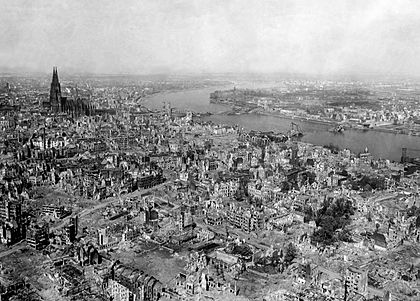
Speer was credited with an "armaments miracle." In the winter of 1941–42, after Germany's defeat in the Battle of Moscow, German leaders believed the war could not be won. Speer used his propaganda skills to show a new energy in the war economy. He produced impressive statistics, claiming a six-fold increase in munitions production and a four-fold increase in artillery. He sent this propaganda to newsreels across the country. This helped stop discussions about ending the war.
However, the armaments "miracle" was a myth. Speer used statistics in a misleading way. While arms production did go up, this was due to reorganizations before Speer took office, the intense use of forced labor, and a deliberate reduction in quality to favor quantity. By July 1943, Speer's armaments propaganda became less important because major defeats on the battlefield meant the German public could no longer be hidden from the reality of losing the war.
Architectural Legacy
Little remains of Speer's architectural work, other than his plans and photographs. In Berlin, only four entrance pavilions and underpasses leading to the Siegessäule (Victory Column) and the Schwerbelastungskörper (heavy load-bearing body) still exist. The Schwerbelastungskörper, a concrete cylinder 46 feet (14 m) high, was built around 1941. It was used to test how much the ground would sink for a massive triumphal arch and other large structures planned for Hitler's post-war rebuilding of Berlin as the world capital, Germania. The cylinder is now a protected landmark and is open to the public. The tribune of the Zeppelinfeld stadium in Nuremberg, though partly demolished, can also be seen.
During the war, the Reich Chancellery designed by Speer was mostly destroyed by air raids and during the Battle of Berlin. The outer walls survived but were later taken down by the Soviets. There are rumors that the remains were used for other building projects in Berlin, like the Humboldt University and the Mohrenstraße metro station.
See Also
 In Spanish: Albert Speer para niños
In Spanish: Albert Speer para niños
- Speer Goes to Hollywood
- Downfall, 2004 German film where he was portrayed by actor Heino Ferch
- Legion Speer
- Transportflotte Speer
- Transportkorps Speer
- Hermann Giesler




